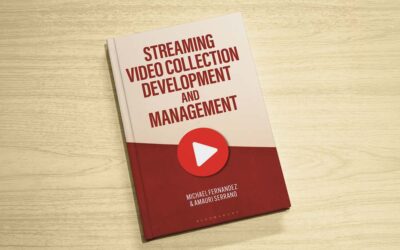Interview with the Authors: Gates and Tonyan; Making the Most of your ILS
Lauren Hays
Lynn E. Gates and Joel D. Tonyan co-wrote Making the Most of Your ILS: A Users’ Guide to Evaluating and Optimizing Library Systems. The book will be published by ABC-CLIO in January of 2023. You can find the book on ABC-CLIO’s site.
I found their book to be very relevant as we all try to optimize technology. My interview with them is below.
Lauren: Please briefly summarize Making the Most of Your ILS: A Users’ Guide to Evaluating and Optimizing Library Systems.
Joel: The integrated library system (ILS) plays a central role in every library’s operations. Depending on how well it’s configured, the ILS can positively or negatively impact these operations, including the workflows and processes involved in cataloging and checking out materials to a library’s patrons.
Our goal in writing this book was to provide ILS administrators and users with a practical guide for getting the most of their library’s ILS. When we began the book, we were acutely aware of how many ILS’s are on the market today, and, consequently, we wrote it as broadly as possible, to be applicable to as many systems as possible. Along the way, we provide foundational information about system security, how to plan and conduct an audit of your ILS’s configuration, tips for documenting important settings, methods for cleaning up field values, and techniques for documenting and optimizing staff workflows. The book culminates with a case study of a project we conducted at our own library—eliminating overdue fees—that brings together everything covered in the previous chapters.
We believe this book is an invaluable resource for new system administrators and longtime users alike, and hope it inspires libraries to take their ILS to the next level.
Lauren: What made you decide to write this book?
Lynn: We had been working on our ILS optimization project for a while and had done a few presentations about it that had been well received. A few years ago, we were presenting about the project at CALCON (the Colorado Association of Libraries Conference) and at the same conference I attended a panel discussion on publishing. One of the panel members was Jessica Gribble, an acquisitions editor from Libraries Unlimited, and she mentioned that she was always looking for new book ideas and accepting proposals. At the time I was looking for a new project and thought a book might be interesting to write, so I proposed it to Joel and another colleague we were working with on the project, and they said yes. So, we wrote up a proposal, sent it to Jessica, and the next thing we knew it was accepted and we had a contract!
Lauren: There are a variety of integrated library systems (ILS) used by libraries, how does the information you provide in the book apply to the different systems?
Joel: In writing this book, we wanted to create a guide that would be useful for all integrated library system administrators and users, regardless of the ILS used at their library. This meant focusing less on what is unique to each system and instead finding common ground amongst the range of ILS’s available today. Although the implementation may vary from vendor to vendor, at their core, all ILS’s provide the same suite of functionality: an acquisitions module for ordering materials, cataloging tools for describing a library’s physical and electronic holdings, circulation functions for loaning materials to patrons, and a web interface that patrons can use to browse a library’s collection. Our book focuses on how to optimize these common functions by adopting our methods for creating good documentation, optimizing staff workflows, and reviewing key system settings.
Lauren: What are two areas of the ILS that are often under-utilized?
Joel: I would have to say security settings. Too often, libraries rely on the default, out-of-the-box security settings that come with their ILS and don’t take the time to further optimize these settings. As librarians, we often think in terms of providing access to our users, but when it comes to ILS security, we need to think like IT professionals and privilege security over access. This means, locking down the ILS to harden it against unauthorized access: Limiting who can access the server remotely, implementing strong password policies, and restricting the permissions staff members have in the system. The less access you provide, the more secure your system will be. Given the amount of patron and financial information housed in a library’s ILS, we have a responsibility to our users and to our institutions to protect this information. As such, every system administrator should take a hard look at their ILS’s security.
Lynn: For me it would be item codes, really any code list in item, order, or patron records, and how they relate to other parts of the ILS like the loan rules. It feels like a lot of the time we need something to happen that’s a little different from something similar and the first thought is to add a new code. Now, sometimes it’s necessary to add a new code, but if there are other ways to accomplish the same thing, why add a new code that needs to be maintained? For example, loan rules can be really powerful, would adding a new, more specific loan rule (maybe it takes item type, location, and patron type into account, instead of just item and patron type) work? Of course, sometimes that doesn’t work and you have to add a new code, but if it’s a code that is necessary for something to happen behind the scenes, can the public display of the view be changed so as not to confuse patrons? For example, most of our equipment has the same loan rules/permissions, but when we started circulating hot spots, we needed a separate rule and didn’t have another way to distinguish them from the rest of our equipment, so we added a new location code, but gave it the same public display as the rest of our equipment so if a user looks it up in our discovery layer or OPAC, they see the same location they would for any equipment.
Lauren: How often do you recommend reviewing the ILS to ensure it is set-up to meet your library’s needs? Why?
Lynn: I would say it’s worth doing a deep dive every 5-7 years or so. That gives you enough time for changes you implemented to become embedded in the daily workflow. There will also be staff turnover, policy changes, and upgrades during that time, all of which may cause you to implement new codes or features that weren’t available during your previous review. I would suggest some surface level reviews happening more often, like reviewing your ILS security and anything that touches on patron privacy concerns. If you don’t want to do a comprehensive review because of the time commitment, you could choose to review different functions or workflows each year.
I would also add that having been through several ILS migrations during my career, I wish we had done an ILS review 18 months or so after the migration. During the migration we are making decisions about a system we aren’t familiar with and then for the first six months or so we are trying to figure out how the new system works and for the most part trying to translate what we were doing to what we are now doing. It takes a good year to become comfortable with the new system. Once you have a better understanding of the new system going back and reviewing the decisions you made as part of the migration, I believe will make you happier with your new system long term, because you’ll have the chance to change your workflows to match your new system instead of continuing with trying to shoehorn your previous workflow into the new system.
Lauren: How important do you feel having a partnership with your ILS vendor is to using your ILS effectively?
Joel: Vendors are a key partner in using your ILS effectively and you should communicate with them regularly, not just when you’re having issues with your system. When our systems librarian took over the administration of our ILS eight years ago, our relationship with our vendor at the time was pretty minimal. The philosophy then was to only engage them to help fix an issue only when we’d exhausted all other options, for instance, consulting the ILS’s manual and reaching out to other users via listservs and contacts at other libraries.
However, we’ve since learned how important it is to establish a stronger relationship with our vendor. Besides opening support tickets on technical issues, we also began regularly communicating with our vendor rep. We used this channel to escalate long-standing issues we were having trouble getting resolved, and to learn about upcoming enhancements that might benefit our library and improve our workflows. As a side benefit, having a stronger partnership with our vendor has aided contract negotiations as well.
Lauren: Is there anything else you would like to share?
Joel: Our library has been with the same ILS vendor for more than two decades and, in that time, employees have come and gone and taken vital institutional memory with them about the inner workings. Thanks to this project, though, we’ve been able to reconstruct quite a bit of this information and have created valuable institutional knowledge around our ILS that will hopefully aid the next generation of librarians at the Kraemer Family Library. Along the way, we’ve learned so much about our ILS and have a much better understanding of how all the pieces fit together. We hope that readers of our book will have the same experience as they follow the strategies outlined in its chapters!
Lynn: Going through the process helped me learn so much about the inner workings of our ILS. Particularly the parts that I don’t use regularly, it was really eye opening to see how what I do in cataloging impacts circulation and vice-versa. While I had a good understanding of how interconnected everything is, it’s really much deeper and more connected than I expected.
Lauren Hays
Lauren Hays, PhD, is an Assistant Professor of Instructional Technology at the University of Central Missouri, and a frequent presenter on topics related to libraries and librarianship. Her expertise includes information literacy, educational technology, and library and information science education. Please read Lauren’s other posts relevant to special librarians. And take a look at Lucidea’s powerful integrated library systems, SydneyEnterprise, and GeniePlus used daily by innovative special librarians in libraries of all types, sizes and budgets.
Never miss another post. Subscribe today!
Similar Posts
Growing Your Leadership Skills: 7 Tips for Special Librarians
Great library leaders aren’t born—they’re made through learning self-reflection and practice. Here are seven strategies to help you grow and lead with impact.
Keeping Up with Copyright and Generative AI: What Special Librarians Need to Know
As generative AI becomes more prevalent copyright law is evolving to address its impact. A new report from the U.S. Copyright Office provides guidance on what is (and isn’t) copyrightable.
Understanding Shadow AI: Risks Costs and Governance
AI can enhance search discovery and efficiency but unsanctioned adoption—known as “shadow AI”—can lead to budget overruns and compliance risks. Here’s how to evaluate AI pricing models and build a governance strategy that balances innovation with cost control.
Interview with an Author: Fernandez on Streaming Video Collection Development
As demand for streaming video in libraries grows so do the challenges of managing access budgets and licensing. Co-author Michael Fernandez shares key insights from his book “Streaming Video Collection Development and Management”.






Leave a Comment
Comments are reviewed and must adhere to our comments policy.
0 Comments